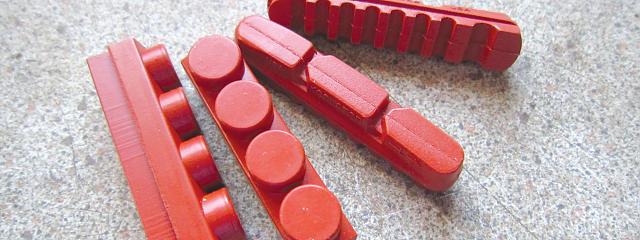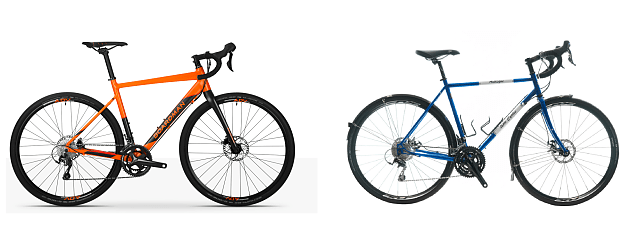
Disc brakes on road bikes
Disc brakes on road bikes
Aren’t disc brakes wonderful and isn’t it time to consign rim brakes to the parts bin of obsolescent cycling technology? This seems to be the prevailing view both within the industry, as Eurobike (right) recently illustrated, and amongst those cyclists who express their opinions on the subject online. There is, however, a countervailing argument worth making, if only to remind potential purchasers that the case is not closed.
The argument for disc brakes rests on three propositions: that disc brakes offer more powerful and controllable braking; that they work more reliably in all conditions; and that they avoid the various problems inherent in using a wheel’s rim as its braking surface. The underlying truth of these is demonstrated by the near-universal use of disc brakes in mountain biking, where a coating of mud usually renders even linear-pull rim brakes ineffective and turns the brake blocks into abrasive pads that quickly wear away the braking surface. And if discs are so far superior in the demanding off-road world, surely they are a shoo-in on the road?
In fact, there are perfectly sound reasons for still choosing rim brakes for road use. Today’s rim brakes have been developed to the point where the best of them arguably offer as much braking performance as most road cyclists can exploit, given the limitations of narrow tyres. At this point, more is superfluous and the belief that more can be used is potentially dangerous, as I found when first trying Magura hydraulic rim brakes.
Disc brake care
There are a few operational niggles to consider too. Cycle disc brakes are usually operated either hydraulically or ‘mechanically’ by conventional Bowden cable, with a third ‘hybrid’ type available that uses a cable to operate a self-contained hydraulic calliper. Cable disc callipers are easy to set up and adjust but do not self-adjust to compensate for pad wear. Comparatively heavy, they lack the power and feel of hydraulic discs but are not susceptible to fluid overheating, although the pad material and disc may get too hot.
Hydraulic operation uses the incompressibility of a fluid to transmit pressure from the brake lever to the calliper. The latest systems self-adjust to compensate for pad wear but installation is a skilled task if the hose needs to be trimmed, and pad replacement can be tricky.
Neither type is immune to a notable problem with disc brakes. It is not too hard to find accounts online of disc brake pads wearing out on wet gravel rides, even when the brakes are hardly being used. To save weight, pads are small and thin; the very close clearances necessarily maintained between pads and disc mean that fine grit on the disc rotor will eat away at the pad. The same process means pads also wear quickly if used for wet weather commuting. So, while discs themselves may be long-lived and using discs will save on rim wear, they entail costs of their own.
Brake fade
Even without grit, pad rub is a common and annoying problem caused by the tiny clearances between pad and disc. It arose when I was testing the Whyte Cornwall for the June-July issue; after re-installing the front wheel, the pads gently rubbed the disc. Wiggling parts made no difference. The cure is usually to re-position the calliper, which is a bit of a faff.
Alongside pad wear sits the possibility of overheating. It’s one that can afflict a bike with rim brakes, of course, but discs are by no means immune. Excess heat can boil hydraulic fluid, leading to complete brake failure as it becomes compressible and can’t transmit pressure. Manufacturers, including Shimano, have fitted fins and heat sinks to callipers and discs to avoid both this and the problem of over-cooking pad material, which will cause it to generate less friction and ‘fade’. The results have not always matched expectation: see bit.ly/ctc-icetechrotors for an account of a melting Ice-Tech rotor…
Bicycle discs are small, contain little metal, and heat up very rapidly under severe usage. Hard braking on a short 25% descent oxidised the discs blue on the Whyte Cornwall within 200 metres. This braking was no harder than on the sidepull-equipped Boardman with which it was compared. So it is not clear that disc brakes are a significantly better proposition on very high speed descents.
Reinforcement required
Fundamentally, however, the drawback for discs is structural. Not only do they require a stiff wheel with tangential spoke lacing to resist brake torque, but the frame and fork must be built to take the loads imposed by the calliper. These are, of necessity, about four times the magnitude of those imposed by rim brakes for the same braking force since a 700C rim is roughly four times the radius of a 160mm disc rotor.
The fork crown or seatstay brake bridge provides a strong location for a brake calliper, while front fork cantilever bosses are brazed to the stiffest part of the legs. A disc calliper, on the other hand, is placed near the tip of the fork blade, which must, therefore, be made stiffer than needed for a rim brake. While the use of carbon-fibre has allowed engineers to build impressively light forks and frames for disc brakes, the requirement for stiffness affects overall ride quality, as does the location of the added weight near the wheel hubs.
Mounting disc callipers to a conventional steel fork is unwise unless the blade is beefed up to suit. Frame builder and disc brake pioneer Chas Roberts found that regular tapered blades would crack in front of the calliper mount as brake torque tried to bend the tip backwards. Indeed, it has been known for a steel fork blade to be ‘unraked’ by the forces involved. A number of manufacturers, including (but not limited to) Surly, Kona and Salsa, have recalled steel forks in recent years. The solution, which is to use a strengthened blade on the disc side, inevitably diminishes the resilience and springiness for which steel road forks are renowned.
Weighing it all up
The weight penalty incurred when adopting disc brakes is in the order of 750g to 1kg. It’s one that is easily overlooked on one of the new breed of disc-equipped lightweight road bikes, but it is there. Stick with modern dual-pivot, linear-pull or well-set up low-profile cantilever rim brakes and you get excellent braking performance along with a significant weight saving. You also get simplicity along with ease of maintenance and repair.
The weight penalty for adopting disc brakes is in the order of 750g to 1kg. It’s easily overlooked on a disc-equipped lightweight road bike, but it is there.
Richard Hallett, Technical Editor of Cycle
There are a couple of situations where discs undoubtedly win on road: when using deep-section carbon fibre clincher rims, which are susceptible to heat build up and consequent tyre blow-off; and for all-weather commuting, where overall performance is largely irrelevant. Then again, if effective all-weather braking with minimal maintenance is the goal, a solution has been available for almost a century but is largely ignored. Drum brakes are sealed against inclement conditions, last almost forever and work a treat but have never been popular. The enthusiasm with which discs have been greeted is in marked contrast and surely says as much about image as about real-life performance.
This was first published in the October/November 2015 edition of Cycling UK's Cycle magazine.
Red hot rotors
Perhaps surprisingly, riding on the road poses a greater problem for discs than off-road as speeds on descents are potentially so much higher and kinetic energy, which is what brakes must absorb, varies as the square of velocity. Participants in high-speed downhill mountain biking events such as Megavalanche have reported complete loss of power after long, hard braking efforts.
At 60mph, a cyclist has nine times the kinetic energy of a cyclist travelling at 20mph and slowing an 80kg bike and rider from 60mph to 20mph in three seconds generates 8.5kW, which heats the disc – to as much as 500ºC depending on front/rear brake usage.
This is more than enough to cause permanent scarring if a hot disc touches skin. By comparison, an aluminium rim might only reach 90ºC in short bursts of braking. Those who dismiss concerns about burns resulting from bunch crashes in road races have surely not experienced mountain biking’s ‘rotor burn’.










